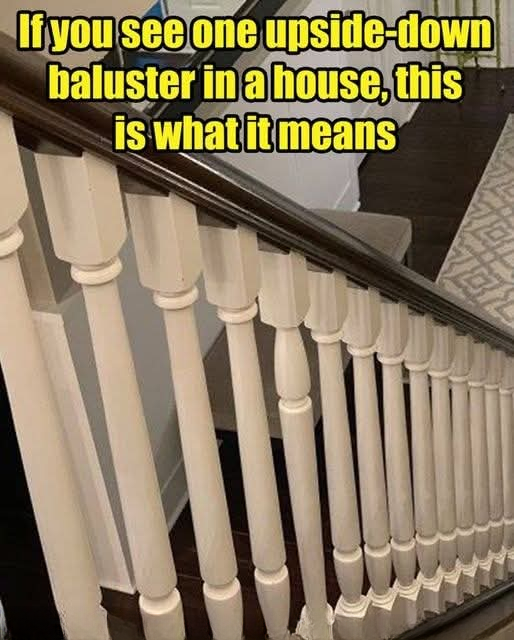Step into an old house — the kind with creaking floors, hand-carved railings, and decades of history settled into its walls — and you might notice something odd on the staircase. One of the balusters, the vertical posts holding the handrail, appears upside down. At first glance, it could seem like a careless mistake. But for those who know the lore and craftsmanship of previous centuries, that single inverted spindle carries layers of meaning, both practical and spiritual.
For generations, carpenters deliberately installed one baluster upside down. It wasn’t an error; it was tradition. In centuries past, builders believed that a single reversed spindle could protect a home from evil spirits. Homes were seen as thresholds between the physical and spiritual worlds, and staircases — connecting floors and often viewed as conduits — were thought to attract both benevolent and malevolent visitors.
The upside-down baluster disrupted the symmetry that spirits were said to follow. According to folklore, dark entities could only move along perfect lines. One flipped post was enough to confuse or deter them. What looks like a flaw to the modern eye was once a talisman carved in plain sight, a guardian for the family that lived there.
Beyond superstition, there was a deeper symbolism at play. Craftsmen often introduced deliberate imperfections as a spiritual acknowledgment: only God is perfect. Flipping a single baluster became a quiet act of humility, a reminder that even the most skilled human hands should not attempt divine perfection. This philosophy appeared in many crafts — from quilts to pottery — and transcended continents and cultures.
Staircases themselves held metaphorical significance. Ascending represented progress, enlightenment, and spiritual growth, while descending suggested humility and return to the earth. The inverted baluster acted as a subtle moral lesson, a symbol of balance and imperfection amid daily life. It reminded those who climbed the stairs that life, like the staircase, was rarely linear or flawless.
The tradition has endured, and in modern times it continues to fascinate. In 2020, HGTV host and builder Scott McGillivray shared a photo of a staircase with an upside-down baluster, captioning it: “One of these things is not like the other.” The post went viral, with viewers debating whether it was a mistake, a stylistic choice, or a nod to old superstition. Many who recognized the practice referred to it as “God’s Flaw,” a deliberate tribute to imperfection.
This architectural quirk wasn’t confined to one region or belief system. In Europe and North America, similar customs were known as the “devil’s trap” or “spirit stopper,” all with the same purpose: protection and acknowledgment of imperfection. Inverted balusters were sometimes added to non-religious homes as well, serving as secret messages from builders to homeowners, a quiet signature of old-world craftsmanship.
The psychological effect of a reversed spindle is also worth noting. Humans are naturally drawn to symmetry and often unsettled by its disruption. A single upside-down baluster stands out, prompting observation and reflection. It invites the viewer to pause, reminding us that imperfection is natural, necessary, and even beautiful. This echoes the Japanese philosophy of wabi-sabi, which celebrates authenticity through flaws.
Walk through older houses in New England, the British countryside, or Central Europe, and these inverted balusters can appear unexpectedly. They blend seamlessly into the design, almost invisible unless specifically sought. Yet once spotted, they transform from simple architectural features into tangible connections with the beliefs, fears, and hopes of past artisans.
Today, the upside-down baluster serves as a reminder that design and symbolism were once inseparable. What may seem like a trivial mistake is actually a whisper from history: humans are fallible, and that fallibility is a strength, not a flaw. So the next time you notice a spindle out of place, consider it more than wood turned the wrong way — see it as a dialogue between past and present, a tiny echo of the spiritual and cultural wisdom embedded in everyday life.
